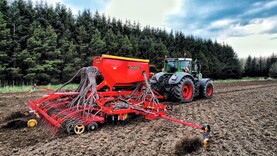Still time for planting: The latter part of this backend is certainly not easy for planting. Rainfall amounts remain variable, but it does not take much water to wet land now that it is cold and it takes it a lot longer to soak. While the weather has been very broken, establishing crops are generally in good condition, except in patches where conditions were dodgy at planting. This should stand to crops, regardless of what the winter brings weather-wise.
Planting: Wheat and oats are the main crops still to be planted, but there are always additional challenges for crop establishment once we get into November. Slugs, crows and rabbits are all more likely to cause damage and this should be factored into seeding rates. Growth and establishment are slower. Crops take longer to establish, so the risks are higher.
While germination may well hold up above 95%, establishment could take a bigger hit as seedbed conditions deteriorate. At 95% germination, 158kg/ha (10st/ac) would give 300 plants/m2 if you got 100% establishment with 50g TGW seed. If establishment dropped to 85% with the same seed, the target plant population would require 186kg/ha (11.83st/ac). It is important to factor this into your seeding rate if planting now. But there is also a balance needed between seed rate and establishment, because higher seed rates always give lower establishment percentage.
Target 380 seeds/m2 for wheat and up to 450 for oats. These equate to 210kg/ha (13.4st/ac) for 50g wheat and 180kg/ha (11.5 st/ac) for 40g oats. An amount of sowing activity taking place in your local area can help dilute crow pressure, especially with oats.
Aphids: All early-sown crops should be sprayed with aphicide and many have already been sprayed. Early October emerged crops can be sprayed around now if you can travel, and if there are signs of aphids in your crop. The drop in air temperatures may remove the need for a second aphicide or even a first one on crops that are still to emerge. But the threat remains active if the weather turns mild again. Remember, aphids can survive up to -8ºC, so while a drop in temperature will only slow multiplication, it is unlikely to reduce numbers where a threat exists.
Pests: Crows have become more active on emerging crops and need to be discouraged where numbers are high. As the weather gets colder, they are more likely to feed in cereal fields. If you see a lot of activity in fields that are not yet emerged, it may be best to take some action to move them on. This is a frustrating task, but failure to do so could result in a significant lowering of plant counts. It is very difficult to keep crows away once they are hungry. Small numbers may only be picking up grubs, but large flocks will dig up seeds or even plants post-emergence. Slugs are also active and slug pellets may be needed in places.






 This is a subscriber-only article
This is a subscriber-only article










SHARING OPTIONS: